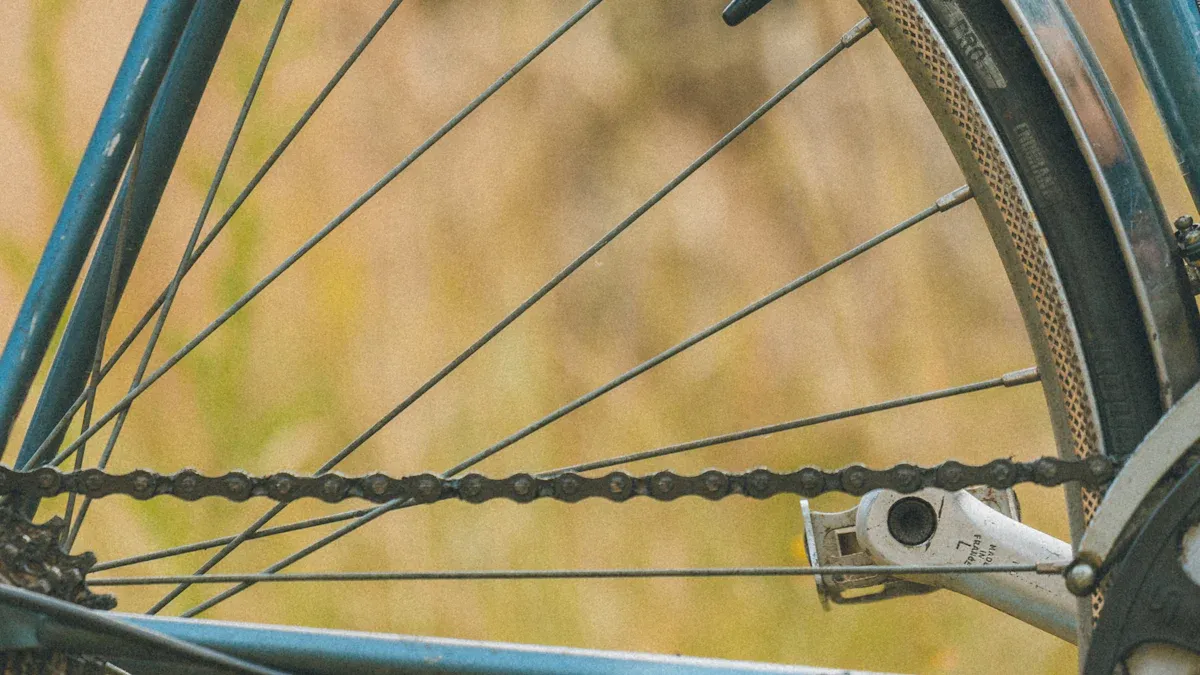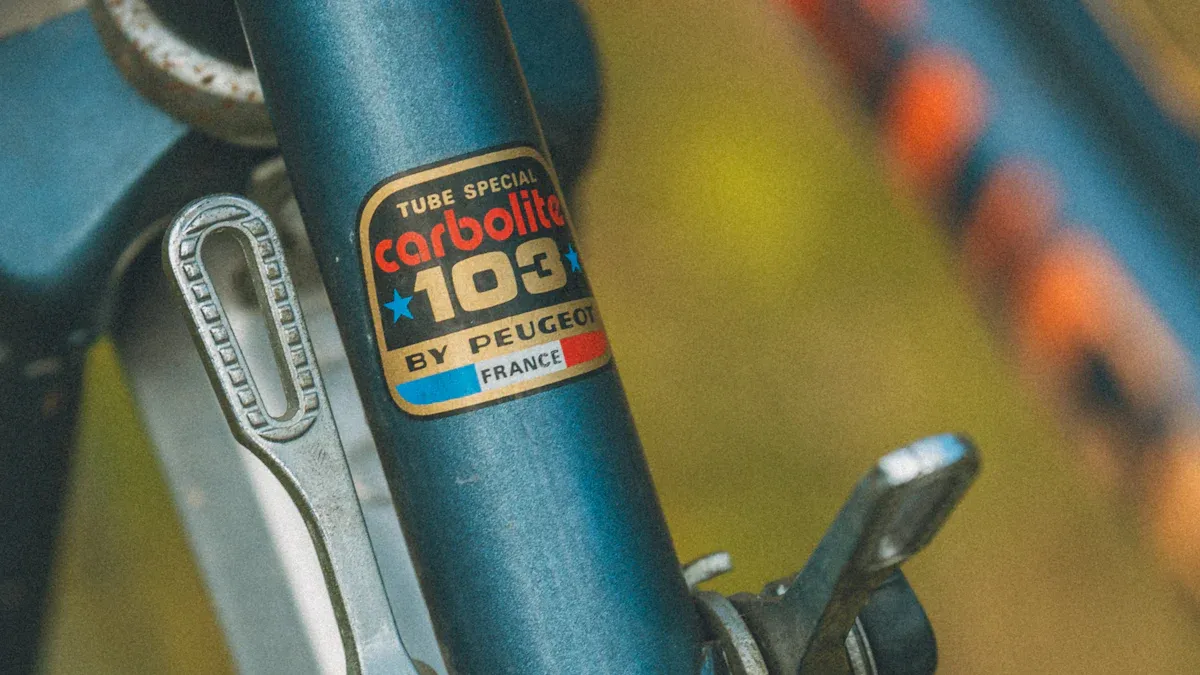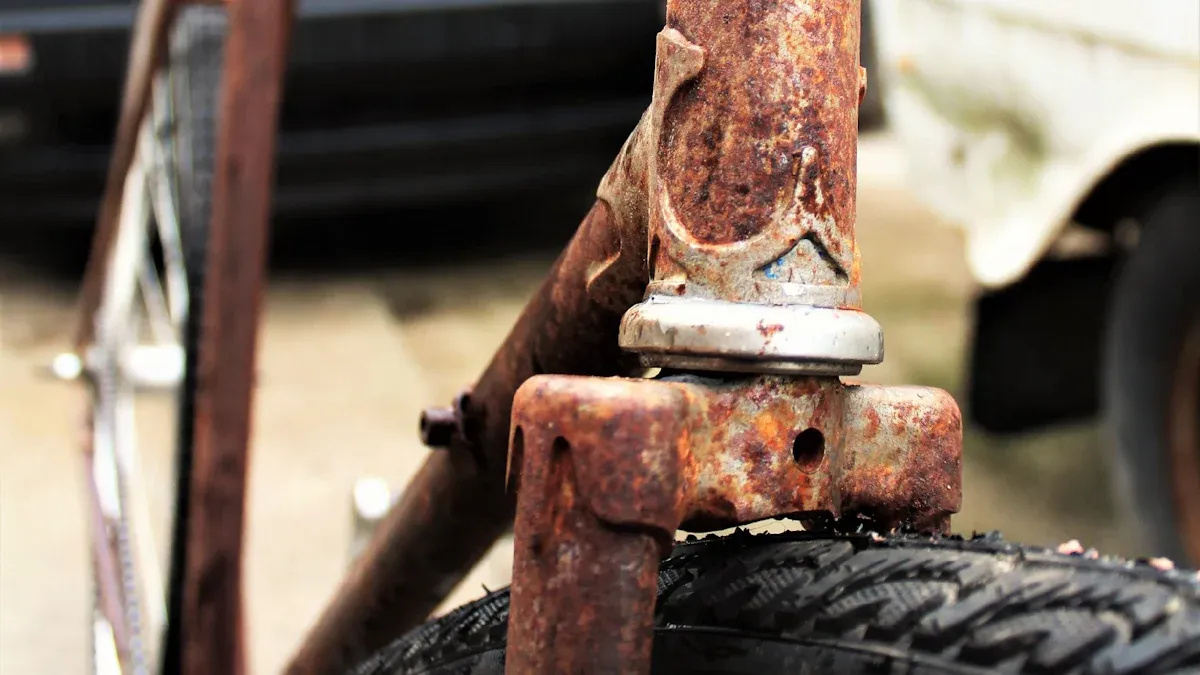
When you look at an antique bike frame, pay attention to these things:
The original condition is very important. Frames with the first paint and decals are worth more.
Check for forged dropouts and good tubing decals like Columbus or Reynolds.
Rare models from famous brands usually cost more money.
Look at the frame and fork for dents, bends, or rust. Any damage can make it worth less.
If the bike has a race history or was owned by someone famous, it is more wanted.
Tip: Ask vintage bike experts or check recent sale prices before you buy an antique bike frame.
Key Takeaways
If a bike frame has its original paint and decals, it is worth more. Good condition also makes it more valuable. – Frames made from strong materials like Reynolds steel are wanted by many people. Forged dropouts also make frames better. – If a famous cyclist owned the frame, collectors want it more. Frames used in races are also very popular. – Rare models and limited editions are special. Unique paint jobs make a frame stand out and worth more. – It helps to know the frame’s story, size, and maker. This information helps you pick valuable antique bikes.
Technological Features in Antique Bike Frame

Frame Geometry
You can tell if a frame is valuable by its shape. In the 1980s, makers made steel frames better. They used new materials and smart designs. These changes made bikes lighter and stronger. Butted steel tubing is thin in the middle and thick at the ends. This makes the bike light but still strong. Brands like Reynolds, Columbus, Vitus, and Tange used good steel alloys. Look for original decals to see what tubing was used. These labels show if the frame has special features. Standard parts like 27.2mm seatposts and rear spacing make frames more useful and wanted.
Tip: Always check for frames with original shape and tubing decals. These details often mean the frame is worth more.
Construction Methods
You can tell how much an old bike frame is worth by how it was made. Frames that use lugged aluminum or steel tubing are worth more. French Meca Dural frames from the 1930s to 1950s used aluminum tubes joined with aluminum lugs and steel expanders. This way of building needed skill and care. Some frames use gas welding, connector bolts, or wedged expanders. Lugged brazing makes smooth joints that look nice and feel good when you ride. TIG welding makes strong and clean joints. Makers pick steel alloys like chromoly for strength and lasting power. Heat treating and coatings help frames last longer. Look for smooth welds and original paint to see if the frame was finished well.
Construction Method | Material Used | Value Impact |
|---|---|---|
Lugged Brazing | Steel/Aluminum | High |
TIG Welding | Steel/Chromoly | High |
Gas Welding | Aluminum | Medium |
Cable Routing
Special cable routing can make a frame stand out. Some rare models, like the 3Rensho Super Record, have cables under the bottom bracket. This keeps cables neat and gives the bike a clean look. Internal cable routing, like on the Colnago Super Oro, runs cables inside the down tube and bottom bracket. These features show smart design and careful work. They also keep cables safe from dirt and damage. Collectors like frames with these special touches because they show new ideas and style.
Under bottom bracket cable guides make the bike look neat.
Internal routing shows good work and makes the frame more wanted.
Protected cables last longer and help the bike work well.
Racing Pedigree in Collectible Bikes
Race History
If you want a valuable bike, check its race history. Bikes used in real races or by famous teams are wanted more. For example, Roger de Vlaeminck’s 1981 Gazelle 753 and Miguel Indurain’s 1995 Pinarello time trial bike have stories collectors like. These bikes have proof of racing in big events. This proof makes the bike special and can make it cost a lot more.
Bikes with race history often sell for higher prices. Most collectible bikes with racing backgrounds cost between $600 and $3,000. Some rare Italian frames, like Masi or Guerciotti, can cost up to $3,000 if they have good history and are in nice shape. If a bike has its original race numbers or special gear from a championship, collectors want it even more.
To see if a bike’s race history is real, look for matching frame numbers, original decals, and special factory marks. Compare these things with old photos or race records. Many collectors ask experts for reports to check if the story is true. These steps help you feel sure about buying the bike.
Tip: Always ask for papers or expert advice before you buy a frame with race history.
Famous Cyclists
Bikes owned by famous cyclists are the most wanted by collectors. If you find a frame from a champion, you get a piece of cycling history. The most valuable frames are linked to legends like Fausto Coppi, Eddy Merckx, and Miguel Indurain.
High-Value Frame Brand(s) | |
|---|---|
Fausto Coppi | Masi, Legnano |
Eddy Merckx | Masi, Peugeot |
Miguel Indurain | Pinarello (Dario Pegoretti) |
Roger de Vlaeminck | Gazelle 753 |
Francesco Moser | Moser |
You might see bikes like Miguel Indurain’s Tour de France-winning Pinarello or Roger de Vlaeminck’s Gazelle 753 become famous in the bike world. These frames have clear stories and are easy to check. If you find a bike linked to a famous rider, it will likely keep or grow in value.
Rarity of Rare Bikes
When you look for valuable bike frames, think about how rare they are. Rare bikes are wanted because collectors like owning something special. These bikes are unique and not many people have them. You can find rare frames by checking for special editions. Look for cool paint jobs or models made in small numbers.
Limited Editions
Limited edition frames are easy to spot. Makers sometimes build only a few to celebrate events or show new ideas. For example, Raleigh made the Professional Mark II in the 1970s. They planned to make 500 frames but made at least 529. Each frame had its own number. All of these frames sold fast. This shows collectors care about how many frames exist. If you find a frame from a limited run, it will be worth more.
Special paint jobs matter too. Custom colors or graphics, like on the Specialized Peter Sagan models, attract collectors. Pivot’s 10th-anniversary bikes also have cool paint. These paint jobs are not just for looks. They make the bike stand out and can raise prices at auctions. Even if a frame looks like others, a rare paint job makes it special.
Low Production Numbers
Frames made in small batches are always wanted. If a builder makes only a few, collectors know it is special. Unique features, like special lugs or engraved parts, make the frame more interesting. Some rare bikes, like early Pogliaghi frames or Zeus models with Zeus 2000 parts, are worth over $1,000 because there are so few.
Here is a table showing the value of some rare models:
Vintage Bike Frame Brand | Approximate Value (USD) | Notes on Rarity and Features |
|---|---|---|
Urago | $1,500 | High-end models with great brazing and French parts |
Pogliaghi (early 70’s) | $1,100+ | Famous builder; early models with N.R. parts are wanted |
Zeus (with Zeus 2000 parts) | $1,200 – $1,500 | Very rare, has special Zeus 2000 parts |
Tommasini (late 70’s) | ~$1,100 | Known for cool engraving and pantographed parts |
Witcomb USA | ~$850 | U.S. branch frames, better than British ones |
Pinarello | ~$900 | Big Italian brand; more wanted because of racing wins |
Viner | ~$700 | Great rider, late 70’s to early 80’s frames |
Windsor | ~$700 | Mexican brand, top frames copy Cinelli |
Palletti | ~$600 | Second tier, best models may be worth more |

If you want to buy rare bikes, look for limited models, special paint, and cool features. These things help you find frames that keep their value and look great in any collection.
Materials in Valuable Vintage Bikes
Steel and Alloys
When you look at vintage bikes, check what steel is used. Good steel alloys make bikes last longer and ride better. Some steel types are wanted more because they are strong and light. They also make the bike smoother to ride. You can find a small sticker on the frame. This sticker tells you what steel alloy the builder used.
Here is a table that shows popular steel alloys in old bike frames:
Steel Alloy | Description | Premium Attributes | Supporting Evidence |
|---|---|---|---|
Reynolds 531 | Classic steel alloy used in many old frames | Used as a standard for comparison | Called standard tubing in vintage frames |
Heat-treated, stronger than 531 by about 10 percent | Stronger than 531 | Reynolds site and people who use it say so | |
Reynolds 725 | Better than 631, found in new Bob Jackson frames | Works better for a small extra cost | Used in Bob Jackson frames, seen as a big upgrade |
Reynolds 853 | Top grade, heat-treated, seamless, air-hardening | Strongest, lightest, needs skilled builders | Reynolds website, user reviews, Bob Jackson charges more for it (£150 extra) |
If you see Reynolds 853 or 725 on a frame, it means the bike is high quality. These alloys make bikes lighter and stiffer. They also last longer and keep their value.
Tip: Always look for original tubing stickers. They help you find frames made with good steel.
Forged Dropouts
Dropouts are the small parts where wheels connect to the frame. How these parts are made shows if the bike is good. Forged dropouts mean the frame is high-end. They are stronger and last longer than stamped dropouts.
Forged dropouts are found on better and more collectible frames.
Stamped dropouts mean the frame is cheaper and not as strong.
Frames with forged dropouts feel solid and sell for more money.
Many French bikes with stamped dropouts, like the Peugeot PX-10, are not as collectible even if they ride well.
Forged dropouts are a quick way to check frame quality and collector interest.
If you want a frame that lasts and keeps its value, look for forged dropouts. They help the bike perform better and make it more wanted.
Condition of Antique Bike Frame

Original Paint and Decals
When you look at an antique bike frame, check the paint and decals first. Collectors like frames with their original paint and decals much more. If the paint or decals are changed, the frame is worth less. The original paint and decals show the bike’s real history. They make the bike feel more special and true. If you find a frame with its first paint in good shape, it can cost more. Sometimes, a frame with original paint sells for $500 to $700. If the paint is bad, it might only sell for a few hundred dollars.
If you take off or change the decals, the price goes down, especially for rare bikes.
If the paint is too damaged, careful fixing with matching decals can help keep the value.
Cool paint designs with original decals after repainting can sometimes make the bike sell for more.
If you want the frame to stay valuable, do not repaint unless the paint is really bad. Most collectors like some old marks and wear instead of a new look.
Tip: True originality is hard to find. If you need to fix the frame, use the right decals and colors to keep its value.
Frame and Fork Integrity
Always check the frame and fork for damage. Look for cracked paint, ripples near the lugs, bent forks, or forks that do not match. These problems often happen from crashes or rough riding. Cracked paint can mean the frame was bent too much. Ripples near the head tube show the frame got hit hard.
Bent or wrong forks change how the bike rides and make it worth less.
Fixes like straightening or changing tubes can hurt the frame’s originality and make it less wanted.
Collectors want frames with matching, undamaged forks and clean lugs.
Frames with damage or repairs usually lose value. For example, a 1982 Motobecane with a new fork lost value because the fork changed the bike’s shape. A 1960s Bianchi with lots of repairs also became less wanted by collectors. When you buy an old bike frame, always look for these problems. Frames that are original and not damaged keep their value best.
Historical and Aesthetic Value
Iconic Designs
When you see an old bike frame, some look special right away. These frames have a style that makes them easy to spot. The designs come from important times in cycling history. For example, handbuilt American frames made before the 1980s are very popular. Builders worked with care and skill to make each frame unique. In the late 1980s and early 1990s, Bridgestone frames by Grant Peterson became well-known. Many collectors want these bikes because of their cool look and story.
You should also notice the model name and when the bike was made. Bikes from the 1980s show a big change in how bikes were built. Makers started using new materials and made more bikes in factories. Handbuilt frames from this time often keep their value or go up in price. Racing and touring bikes from these years usually cost more than mountain bikes. People like to remember the past, and a brand’s good name can make prices higher. If you find a frame with a rare style or one made in small numbers, it could be very special.
Tip: Try to find frames with original parts and designs that have a story. These bikes often become the most wanted in a collection.
Country of Manufacture
Where a bike frame is made can change how much people want it and what it costs. Some collectors like bikes made in their own country. They feel proud and trust the quality. Others care more about the brand and how the bike rides. American or Canadian frames sometimes cost more because of local support and higher pay for workers. Some buyers pay extra for bikes made at home for personal reasons.
Here are some countries known for valuable old bike frames:
Country | Notable Vintage Brands and Highlights |
|---|---|
France | Gitane (Tour de France wins), Peugeot (since 1882), Motobecane (historic maker) |
Italy | Bianchi (oldest maker), Colnago, De Rosa, Pinarello (Tour de France wins), Cinelli, Masi, Olmo |
Japan | Fuji (since 1899), Bridgestone (cult following), Miyata, Panasonic, Sekine, Shogun |
Belgium | Eddy Merckx (started by a cycling legend) |
Netherlands | Concorde (high-quality road bikes) |
You should know that workers in Taiwan also make great frames. Some Asian factories use good tools and skilled workers to build strong, light bikes. The country where a bike is made can change the price, but it is not the only thing that matters. The brand’s name, warranty, and the bike’s story are also important. When you pick a frame, think about what is most important to you—how it was made, local support, or the bike’s own story.
The best antique bike frames are worth more if they have their first paint, rare metals, special stories, and a racing past. You should always learn about the frame’s history and make sure it is real.
Look up the model and its parts.
Check facts with brand sites and expert pages.
Try to get official proof if you can.
Online groups and talking to collectors give extra info.
If you do these things, you will pick better bikes and your collection will be worth more.
FAQ
How can you tell if a bike frame is truly antique?
You can check the serial number, decals, and frame details. Compare these with catalogs or online resources. Ask experts if you feel unsure. Look for signs of age, like old paint or classic lugs.
Does repainting an old frame lower its value?
Yes, repainting usually lowers the value. Collectors want original paint and decals. If you must repaint, use the correct colors and decals. Keep photos of the frame before and after any work.
What is the best way to store an antique bike frame?
Store your frame indoors. Keep it dry and away from sunlight. Use padded hooks or stands. Avoid damp places. Cover the frame with a soft cloth to protect the paint.
Are all rare bike frames valuable?
Not always. Rarity helps, but condition, brand, and history matter more. A rare frame in poor shape or from an unknown maker may not be worth much. Research before you buy or sell.
See Also
Key Characteristics That Make A Bike Frame Classic In 2025
Essential Retro Bike Frame Details Every Enthusiast Should Know
How To Restore A Wrapped Bike Frame To Its Original Shine
The Evolution Of Steel Road Bike Frames Through Craft And Innovation
Comparing Enduro Bike Frame Materials For Durability And Performance
